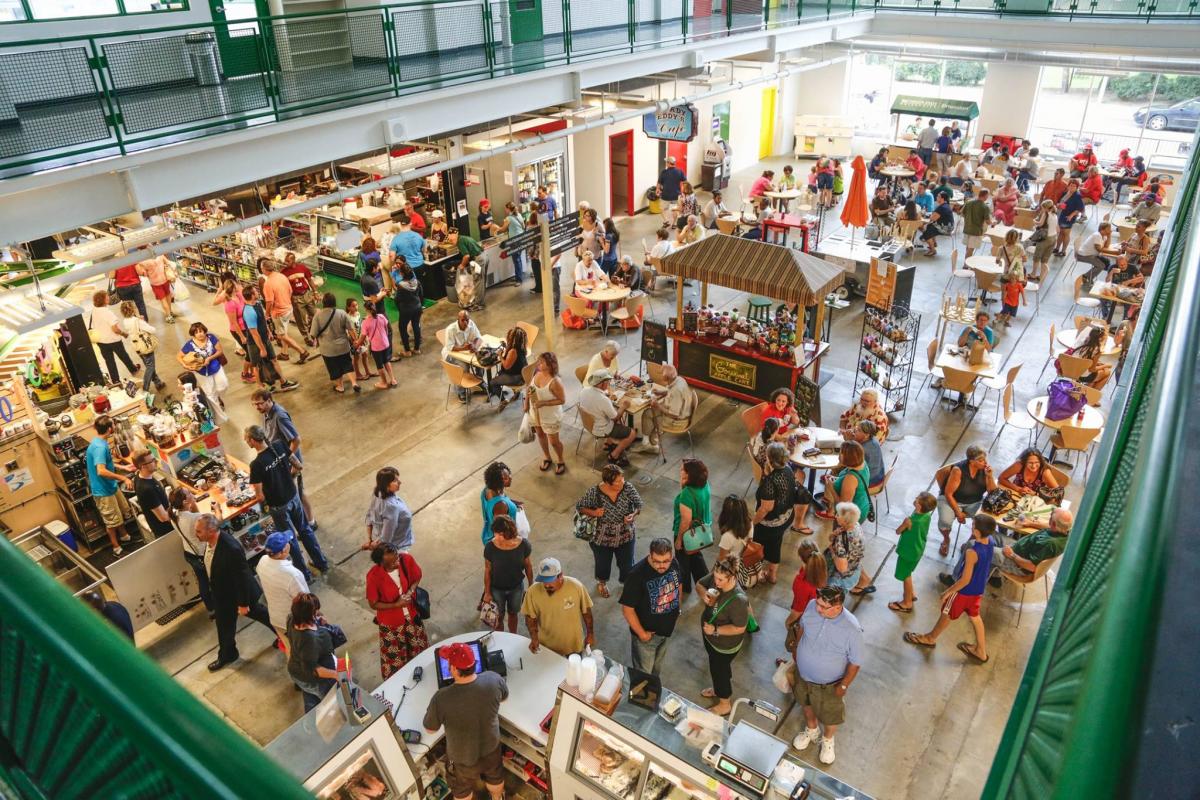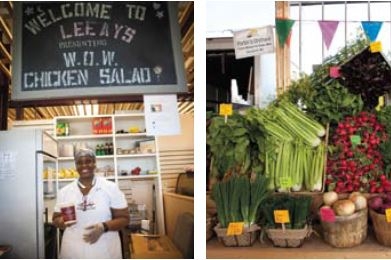The Flint Farmers’ Market Returns to its Roots
Visitors to the daylit atrium of the new downtown Flint Farmers’ Market may not realize it, but they are standing in a space made possible by the decline of the print newspaper industry. That’s because the new market occupies the building of the former Flint Journal, which built the facility and the tall atrium to house its mammoth printing presses in 2004.
Back then, Flint Market Manager Dick Ramsdell was on a tour of the new building and immediately recognized its potential beyond printing newspapers. “I thought to myself, ‘Oh, my gosh, this would make a beautiful market,’” Ramsdell recalls. Ramsdell had been keeping his eye out for a downtown market location. One of the main recommendations of the 2003 Flint Uptown Reinvestment Strategy to help the city transition from a factory town to a college town was to get the market back into the downtown.
The original Flint Market operated from 1920 until 1940 in downtown at the corner of Harrison and Union. By 1940, merchants complained of congestion, and the market was moved just outside of downtown to the banks of the Flint River on East Boulevard Street, where it flourished for many years. By the 1980s, however, the quality of the market began to decline along with the automotive industry and the city’s fortunes in general, so that by the late 1990s, the market was filled mostly with flea-market-type enterprises.
In 2002, Uptown Reinvestment Corporation, a nonprofit organization with a focus on revitalizing downtown Flint, took over management of the market from the city and brought Ramsdell on board as manager.
A retired high school social studies teacher, Ramsdell had no experience managing a market. Over the next decade, he focused on common-sense measures. “We did some very basic stuff,” he says. “First was to balance the books and collect rent honestly and put it back into the market. Second was to keep it clean. I didn’t know what I was doing. It was mostly just a matter of trying to run the business with common sense. We asked some people to leave either because they didn’t pay their rent or their products were not anything that should have been on the shelves.”
Over time, solid market management improved the experience and reputation of the Flint Market and built confidence that the enterprise could succeed as part of downtown’s revitalization. “What I am most proud of is that we were able to bring in real market-type businesses that did succeed and have made the transition with us to this new location,” says Ramsdell. “It took 10 years, but over that period we built the market up and built confidence in the community.”
So when the Flint Journal changed its business model to digital in 2011 and vacated the building at 300 East First Street, Uptown Development stepped in immediately to buy the property. And so Ramsdell’s wish came true.
The new Flint Farmers’ Market operates year-round with 50 indoor vendor spaces including produce, a meat market, bakeries, cheeses, a wine shop, an art gallery, ethnic groceries and artisanal products. The facility also includes an open-air shed, a café area in the atrium, a pavilion for cooking demonstrations and an event room. The ceiling was lowered across the vendor space both to allow for leasable office space as well as to create a sense of human scale for the market vendors and patrons.
“The more successful markets we have toured have a good sense of scale,” says architect Shannon Easter White, who designed the project. “Proportion is important to make people feel cozy, and so vendors feel like they have their own space.”
The market is also home to an incubator kitchen, Flint Food Works, which operates as a separate business. Sean Gartland doubles as facilities manager for the market and culinary director for Flint Food Works. Because the kitchen is able to operate rent-free, it can offer low rates to startups. Gartland, a Flint native who did stints as a chef and cooking instructor in Chicago, hopes the incubator and demonstration kitchen will spark new local connections between chefs, food producers and growers.
“You don’t see a ton of the farm-to-fork movement in the Flint area, and I want chefs to start thinking more locally about their purchases,” he says. Gartland is working closely with Genesee Regional Chamber of Commerce’s small-business counselors and Metro Community Development, a community development financial institution, to help with writing business and marketing plans and securing financing to help tenants grow out of the incubator kitchen.
“I don’t want people to be here for a lifetime,” says Gartland. “I want them to be here for about 24 months and then come to me and say ‘I have too much business now and I need to look into getting my own storefront.’”
As for Ramsdell, he is looking forward to passing on the reins eventually. “I’ve been asked what it takes to make a market successful,” he says. “It wasn’t very dramatic. If you put a good face on things and do it right, you will attract attention, and that’s what has continued to happen.”
Learn more at Flint Farmers Market








